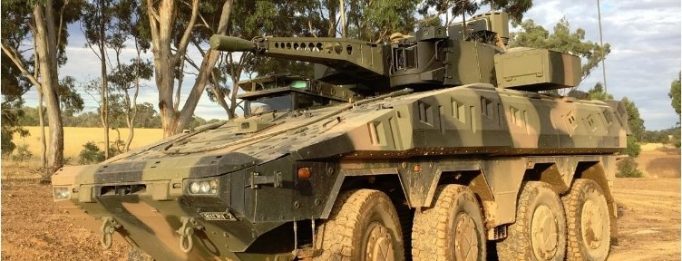
At the 2018 AUSA meeting (Association of the U.S. Army) the army discussed its continuing evaluation of APS (Active Protection Systems) for the Stryker combat vehicle. This is part of an overall effort to develop and deploy APS on almost all ground combat vehicles. From DefenseNews.com :
“More than a year ago, the Army determined it needed to field an interim APS solution for the Abrams tank as well as the Stryker and Bradley. The service decided to rapidly assess off-the-shelf APS systems to fulfill an urgent operational need after failing — over a 20-year period — to field an APS capability.”
As a result, the Army distributed an RFP earlier in the year for APS system proposals. While four companies responded, only two were considered ready for prime time and were invited to a live-fire rodeo in November to see if either was ready to be an interim solution for combat vehicles while they search for a permanent APS solution.
Invited to the rodeo were Israeli company Rafael’s Trophy VPS, a lighter version of the Trophy system that’s serving as the interim protection solution for the Abrams tank. Also invited was Germany-based Rheinmetall’s Active Defense System. Each will have a chance to show the Army capabilities that could go on a Stryker, or potentially another system.
CPI’s Unique APS, the ARC system
Notably missing from the Defense department’s November shootout, was the CPI RPG Shield system know as the “ARC” system. ARC stands for Active Rotating Countermeasure and represents a threat protection paradigm with significant advantages over both the systems recently invited to the Army’s shootout.
- Low Cost – Even the German government declined to go with Rheimetall’s solution due to its high cost. The CPI system integrates into existing LIDAR
 paradigm’s and has a rotating turret of much greater mechanical simplicity.
paradigm’s and has a rotating turret of much greater mechanical simplicity. - Highly Flexible Munition Array – The CPI system is the only system to allow for deployment of multiple specialized munitions in one firing assembly. Munitions can be tailored to the threat through software without need to deploy a different system in a different operational theater.
- Operations on hoovering Aircraft – Current systems are highly specialized to operating best on only certain vehicles. The Trophy system for the Abrams Tank, the Rheinmetall’s system is best suited to Stryker. But the CPI system has characteristics that make it largely vehicle agnostic. Two versions of the rotating turret, one for ground vehicles and one for aircraft are likely all that would be needed. The differences in operation are encapsulated in the selection of munitions.
The Army’s need for a short term solution to APS is certainly understood. But it’s long term needs may be best served by a system like the CPI ARC system as no system currently under consideration has the operational potential of this threat detection and defeat paradigm or as low a projected cost.
CPI is actively looking for a partner to license and develop this technology. For more information visit our Arc System pages or contact us directly at 973-887-9400
Original content posted on https://www.cpi-nj.com/blog/active-protection-systems-for-the-army-and-beyond/


 According to sources with combat experience, the RPG is most typically a “100-yard weapon”. Adversaries know that to be effective, the RPG needs to be fired at close range. The RPG-7’s maximum flight velocity is around 300 meters per second, so assuming roughly 100 yards to target, it could take as little as 300 milliseconds from launch to impact. Given that any (aimed) active defensive system must detect the inbound threat, classify it, process a response, and aim and launch the countermeasure before the threat makes contact; a realistic system design goal would require the aiming mechanism to be capable of addressing a threat from any direction in 100 milliseconds or less. There is presently no traditional “gun and gimbal” turret system that can aim this rapidly.
According to sources with combat experience, the RPG is most typically a “100-yard weapon”. Adversaries know that to be effective, the RPG needs to be fired at close range. The RPG-7’s maximum flight velocity is around 300 meters per second, so assuming roughly 100 yards to target, it could take as little as 300 milliseconds from launch to impact. Given that any (aimed) active defensive system must detect the inbound threat, classify it, process a response, and aim and launch the countermeasure before the threat makes contact; a realistic system design goal would require the aiming mechanism to be capable of addressing a threat from any direction in 100 milliseconds or less. There is presently no traditional “gun and gimbal” turret system that can aim this rapidly. For RPG defense, a continuously-rotating countermeasure aiming and launching system provides a much faster response than a traditional “gun and gimbal” turret system. Many active RPG countermeasures are self-propelled munitions. They do not require robust gun barrels for launch. They may be launched from short tubes that are little more than storage capsules. Self-propelled munitions also do not produce significant recoil. We propose a design of a fast aiming-and-launch system in the form of a rotating drum. This drum-shaped countermeasure launch container houses multiple munitions, each in a short launch tube, in an outwardly-facing circular array. The circular array lies on a plane perpendicular to the drum’s axis. Given that the launch tube is only about as long as the munition itself, this circular array could be realized in a drum-shaped launcher whose overall diameter is slightly larger than twice the length of an individual countermeasure round. Rotating the drum about its axis creates a situation in which any point, or multiple points, on a planar azimuth of rotation are continuously brought into the line of fire of the munitions in the array. Any point within a full 360 degrees can be targeted in the time that it takes to rotate the nearest-available munition (array element) to that point. In one example, 8 countermeasure munitions are arranged in the outward-facing 360 degree circular array with munitions spaced equally every 45 degrees. In this example the drum must rotate (at most) 45 degrees in order to bring the nearest munition to any point around a 360-degree azimuth. Depending upon the rotational speed of the drum, the time required to bring munitions to bear could be on the order of milliseconds. The preceding description provides a rotational turret capable of firing 8 countermeasures. However a drum-shaped launcher suggests the possibility of superposing (stacking) multiple arrays of countermeasures. So a single drum-type launcher is capable of firing 16 or more defensive munitions prior to reloading and would not potentially require a second instantiation of the turret for multiple threat detection.
For RPG defense, a continuously-rotating countermeasure aiming and launching system provides a much faster response than a traditional “gun and gimbal” turret system. Many active RPG countermeasures are self-propelled munitions. They do not require robust gun barrels for launch. They may be launched from short tubes that are little more than storage capsules. Self-propelled munitions also do not produce significant recoil. We propose a design of a fast aiming-and-launch system in the form of a rotating drum. This drum-shaped countermeasure launch container houses multiple munitions, each in a short launch tube, in an outwardly-facing circular array. The circular array lies on a plane perpendicular to the drum’s axis. Given that the launch tube is only about as long as the munition itself, this circular array could be realized in a drum-shaped launcher whose overall diameter is slightly larger than twice the length of an individual countermeasure round. Rotating the drum about its axis creates a situation in which any point, or multiple points, on a planar azimuth of rotation are continuously brought into the line of fire of the munitions in the array. Any point within a full 360 degrees can be targeted in the time that it takes to rotate the nearest-available munition (array element) to that point. In one example, 8 countermeasure munitions are arranged in the outward-facing 360 degree circular array with munitions spaced equally every 45 degrees. In this example the drum must rotate (at most) 45 degrees in order to bring the nearest munition to any point around a 360-degree azimuth. Depending upon the rotational speed of the drum, the time required to bring munitions to bear could be on the order of milliseconds. The preceding description provides a rotational turret capable of firing 8 countermeasures. However a drum-shaped launcher suggests the possibility of superposing (stacking) multiple arrays of countermeasures. So a single drum-type launcher is capable of firing 16 or more defensive munitions prior to reloading and would not potentially require a second instantiation of the turret for multiple threat detection. Further calculations on a drum that rotates about as fast as a ceiling fan (300 RPM), show that a countermeasure could be delivered to any point on the azimuth in 25 milliseconds or less. This is roughly the amount of time that it takes an RPG to cover about 7 meters.
Further calculations on a drum that rotates about as fast as a ceiling fan (300 RPM), show that a countermeasure could be delivered to any point on the azimuth in 25 milliseconds or less. This is roughly the amount of time that it takes an RPG to cover about 7 meters.